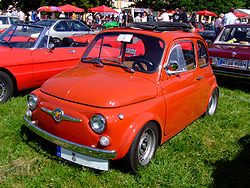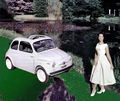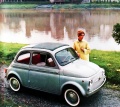Fiat 500

| |
| Fiat 500 | |
|---|---|
| Manufacturer: | Fiat |
| Production: | 1957—1975 |
| Class: | City car |
| Layout: | RR layout |
| Body style: | 2-door coupé 3-door estate |
| Engine: | 479cc Flat-2 499cc Flat-2 594cc Flat-2 |
| Transmission: | Manual 4-speed |
| Length: | 2.97 m |
| Width: | 1.32 m |
| Height: | 1.32 m |
| Weight: | 499 kg |
| Wheelbase: | 1.84 m |
| Predecessor: | Fiat Topolino |
| Successor: | Fiat 126 |
| Designer: | Dante Giacosa |
- "500" can also refer to the later Fiat Cinquecento or to the new Fiat Nuova 500
The Fiat 500 (the "cinquecento" from the Italian word for "500") is a car produced by the Fiat company of Italy between 1957 and 1975 (the Fiat 500 K alone was produced until 1977).
Launched as the Nuova 500, it was marketed as a cheap and practical town car to combat high levels of congestion in Italian cities. Measuring only 2.97 m (9 ft 9 in) long, and originally powered by a tiny 479 cc two-cylinder, aircooled engine, the 500 redefined the term "small car" and is considered one of the first city cars.
History
To meet the demands of the post-war market which called for economy cars, the Fiat 500 was rear-engined on the pattern of the Volkswagen Beetle. Several car makers followed this now nearly vanished pattern at the time and were quite successful. But only the Fiat 500 was used as the pattern for other car makers in Europe. The firms Neckar of Germany and Steyr-Puch in Austria each made cars that were legally based on the Fiat 500.
Despite its diminutive size, the 500 proved to be an enormously practical and popular vehicle throughout Europe. Besides the two-door coupé, it was also available as the "Giardiniera" station wagon; this variant featured the standard engine laid on its side, the wheelbase lengthened by 10 cm (4 in) which yielded a usable rear seat, a full-length sunroof, and larger brakes from the Fiat 600.
Production of the 500 ended in 1975, although its replacement, the Fiat 126, was launched two years earlier. The 126 was never as popular as its predecessor in Italy, but was (and still is) enormously popular in the former Eastern Bloc countries, where it is famed for mechanical durability and economy.
Models
There were six main models of Fiat 500 produced by Fiat themselves:
Nuova - (1957-1960)
The original 500, the Nuova has a smaller engine than all newer models, at 479cc and producing just 13 bhp. The original model also features a roof folding all the way back to the rear of the vehicle, like that of a 2CV rather than the later roof design which only folds half way back along the roof. The Nuova is one of three models featuring "suicide doors". There is also a stylish Sport version of the Nuova, which features a distinctive red stripe and a more powerful engine, bored out to 499.5cc from the original 479cc engine and with a longer stroke, thus producing an impressive 21 bhp from the same original block.
D - (1960-1969)
Replacing the original Nuova in 1960, the D looks very similar to the Nuova, but there are two key differences. One is the engine size (the D features an uprated 499cc engine producing 17 bhp as standard - this engine is used right through until the end of the L in 1973) and the other is the roof (the D roof does not fold back as far as the roof on the Nuova). The D also features "suicide doors".
K or Giardiniera - (1960-1977)
The longest running model, this is the estate version of the Fiat 500. The engine is laid under the floor of the boot to create a flat loading surface. The roof on this model also stretches all the way to the rear, not stopping above the driver and front passenger as it does in other models of the same period. Very useful if you need to carry a "tall" load! The K also features "suicide doors" and is the only model to continue to sport this door type in to the 1970s.
F or Berlina - (1965-1972)
The F spans two periods of 500 production, the D and the L. As such, it is the most frequently misidentified model. Between 1965 and 1969 the F carried the same badging as the D and the two models are only distinguishable by their doors - the D has "suicide doors" and the F does not. Between 1969 and 1972 the F was sold alongside the Luxo model as a cheaper "base model" alternative. While the F and L are mechanically very similar, the key differences are the bumpers (the L has an extra chrome nudge bar) and the interior (the F interior is nearly identical to the original 1957 design while the L sports a much more modern look).
L or Lusso - (1968-1972)
The penultimate model, the main change for the L is a much modernised interior which brought the Fiat 500 up to date. Greater comfort and style were provided in this new model for the new generation.
R or Rinnovata - (1972-1975)
The last incarnation of the Fiat 500, the R, was arguably the best model. It had a larger 594cc engine, giving it a much more sensible power rating of 23 bhp, and a syncromesh gearbox for the first time. It was also more comfortable and better equipped than ever. Sadly, it was also merely a stop-gap for Fiat prior to the launch of the Fiat 126, and when the new car was launched sales of the old Fiat 500 R naturally plummeted. It plodded along for another two years beside the Fiat 126 but in the end Fiat made the only sensible choice - to retire the Fiat 500 R once and for all.
2007 model
Main Article Fiat Nuova 500
Fiat will collaborate with Ford on a reincarnation of the 500 which will share underpinnings with the next Ford Ka. It will be based on the Fiat Panda platform. Production is currently scheduled for 2007 and commercial debut in September of 2007. This car will feature distinctive retro-look just like the Volkswagen New Beetle and BMW MINI but may well be substantially cheaper than those cars, with a projected starting price possibly as low as £5000. [1]
Trivia
- On April 18, 2005 a 1973 Fiat 500 linked Bari, Italy, to Beijing, China, in a 16,000 km journey across the whole Russia and passing through Vladivostok. Driven for 100 days by Danilo Elia and Fabrizio Bonserio, the old and tiny car was followed along its journey by newspapers and television from all over the world. After the long journey Elia wrote a book entitled La bizzarra impresa (ISBN 88-7480-088-6), now available only in Italian.
- The Fiat 500 was used by Lupin III, the protagonist of the Lupin the 3rd series and movies.
- A side character on the Disney/Pixar film Cars is a 1959 Fiat 500 named Luigi, voiced by Tony Shalhoub.
- It is also crowned as the sexiest car in the world by the British Top Gear magazine.
- Rockstar Games paid homage to the Fiat 500 in their game 'Grand Theft Auto: London 1969', a mission pack for the popular first Grand Theft Auto game. Although badged as a 'Fat' (instead of 'Fiat'), it is clear that it is supposed to resemble the Fiat 500.
- The song 500 by Lush (on the album "Lovelife") is a lovesong written to a Fiat 500.
- The famous Michael Caine movie, The Italian Job, was due to feature the Fiat 500, but the Mini burst on to the scene just in time (or not, depending on your point of view!)
- This car appears in the Sega arcade game OutRunners under the name Quick Reactor, and it is an orange car.
See also
- Fiat Topolino (the "original" Fiat 500)
- Bianchina (based on the 500)
- Fiat 126 (replacement for the Fiat 500)
- Fiat Cinquecento (a modern Fiat 500)
- Fiat Nuova 500 (the future retro-style 500)
External links
- Fiat 500 History -Gizmohighway Auto Guide
- Fiat 500
- UK Fiat 500 Owners Club
- 500 Wants You
- Ducati-powered, 150bhp Fiat 500!
- 1967 Fiat Giardiniera 500 1.jpg
1967 Fiat Giardiniera 500
- 1967 Fiat Giardiniera 500 2.jpg
- 1967 Fiat Giardiniera 500 3.jpg
- 1967 Fiat Giardiniera 500 4.jpg
- 1967 Fiat Giardiniera 500 5.jpg
- 1967 Fiat Giardiniera 500 6.jpg
- 1967 Fiat Giardiniera 500 7.jpg
- 1967 Fiat Giardiniera 500 8.jpg
- 1967 Fiat Giardiniera 500 9.jpg
- 1967 Fiat Giardiniera 500 10.jpg
- 1967 Fiat Giardiniera 500 11.jpg
See also
- Fiat Topolino (The "original" Fiat 500)
- Fiat Cinquecento (The modern Fiat 500)
| Fiat car timeline, European market, 1899s-1949s Next -> | ||||||||||||||||||||||||||||||||||||||||||||||||||||
|---|---|---|---|---|---|---|---|---|---|---|---|---|---|---|---|---|---|---|---|---|---|---|---|---|---|---|---|---|---|---|---|---|---|---|---|---|---|---|---|---|---|---|---|---|---|---|---|---|---|---|---|---|
| Type | 1890s | 1900s | 1910s | 1920s | 1930s | 1940s | ||||||||||||||||||||||||||||||||||||||||||||||
| 8 | 9 | 0 | 1 | 2 | 3 | 4 | 5 | 6 | 7 | 8 | 9 | 0 | 1 | 2 | 3 | 4 | 5 | 6 | 7 | 8 | 9 | 0 | 1 | 2 | 3 | 4 | 5 | 6 | 7 | 8 | 9 | 0 | 1 | 2 | 3 | 4 | 5 | 6 | 7 | 8 | 9 | 0 | 1 | 2 | 3 | 4 | 5 | 6 | 7 | 8 | 9 | |
| City car | 3,5 HP | 500 A / 500 B (Topolino) ... | ||||||||||||||||||||||||||||||||||||||||||||||||||
| Small family car | 6 HP 8 HP 10 HP |
509 / 509 S | 508 (Ballila) | Ballila 1100 A / B ... | ||||||||||||||||||||||||||||||||||||||||||||||||
| Family car | 1 | 1A / Zero | 70 | 501 / 501 S / 502 / 503 | 514 / 515 | 1500 | ||||||||||||||||||||||||||||||||||||||||||||||
| Large family car | Brevetti | 2 | 2B | 505 | 507 | 518 | ||||||||||||||||||||||||||||||||||||||||||||||
| 12 HP / 16-20 HP / 16-24 HP | 15-25 HP Brevetti | 520 / 521 | 522 / 524 | 527 | 2800 | |||||||||||||||||||||||||||||||||||||||||||||||
| Executive car | 20-30 HP | 3 | 3A / 3Ter | 510 | 512 | 525 / 525 S | ||||||||||||||||||||||||||||||||||||||||||||||
| 24-32 HP / 60 HP | 28-40 HP / 30-45 HP / 50 HP | 4 / 5 / 6 | 520 "Superfiat" | 519 / 519 S | ||||||||||||||||||||||||||||||||||||||||||||||||
| Race car | ||||||||||||||||||||||||||||||||||||||||||||||||||||
| 130 HP Corsa | ||||||||||||||||||||||||||||||||||||||||||||||||||||
| <- Previous Fiat car timeline, European market, 1960s-1980s Next -> | ||||||||||||||||||||||||||||||||||||||||||||||||||
|---|---|---|---|---|---|---|---|---|---|---|---|---|---|---|---|---|---|---|---|---|---|---|---|---|---|---|---|---|---|---|---|---|---|---|---|---|---|---|---|---|---|---|---|---|---|---|---|---|---|---|
| Type | 1960s | 1970s | 1980s | |||||||||||||||||||||||||||||||||||||||||||||||
| 0 | 1 | 2 | 3 | 4 | 5 | 6 | 7 | 8 | 9 | 0 | 1 | 2 | 3 | 4 | 5 | 6 | 7 | 8 | 9 | 0 | 1 | 2 | 3 | 4 | 5 | 6 | 7 | 8 | 9 | |||||||||||||||||||||
| City car | 500 | 126 | ||||||||||||||||||||||||||||||||||||||||||||||||
| 600 | 133 | Panda | ||||||||||||||||||||||||||||||||||||||||||||||||
| Supermini | 850 | 127 | Uno | |||||||||||||||||||||||||||||||||||||||||||||||
| Small family car | 1100 | 128 | Ritmo | Tipo | ||||||||||||||||||||||||||||||||||||||||||||||
| 1300 | 124 | 131 | Regata | |||||||||||||||||||||||||||||||||||||||||||||||
| Large family car | 1500 | 125 | 132 | Argenta | Croma I | |||||||||||||||||||||||||||||||||||||||||||||
| Executive car | 2300 | 130 | ||||||||||||||||||||||||||||||||||||||||||||||||
| Coupé / Roadster | Dino / 124 Sport Spider | 124 Sport Spider | ||||||||||||||||||||||||||||||||||||||||||||||||
| 124 Coupé | ||||||||||||||||||||||||||||||||||||||||||||||||||
| Sports car | 850 Spider | X1/9 | ||||||||||||||||||||||||||||||||||||||||||||||||
| Panel van | Fiorino I | Fiorino II | ||||||||||||||||||||||||||||||||||||||||||||||||
| Compact MPV | 600 Multipla | |||||||||||||||||||||||||||||||||||||||||||||||||
| Van | 600 T | 850 T | 900 T | |||||||||||||||||||||||||||||||||||||||||||||||
| 1100 BLR / ELR / I / T | 238 | |||||||||||||||||||||||||||||||||||||||||||||||||
| 241 | 242 | |||||||||||||||||||||||||||||||||||||||||||||||||
| Daily* | ||||||||||||||||||||||||||||||||||||||||||||||||||
| Ducato I | ||||||||||||||||||||||||||||||||||||||||||||||||||
| Off-road | Campagnola (1101) | Campagnola (1107) | ||||||||||||||||||||||||||||||||||||||||||||||||
| *Rebadged Iveco model | ||||||||||||||||||||||||||||||||||||||||||||||||||





















